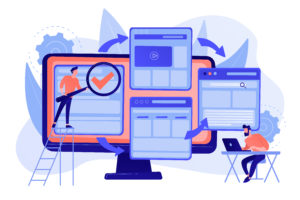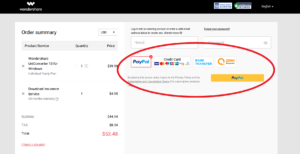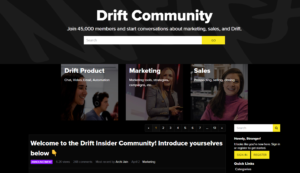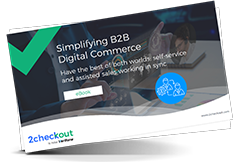With global revenues today totaling close to $8 trillion (US) and growing by 18.7% CAGR, B2B eCommerce is simply too big and valuable for any commercial company to ignore or take for granted. Thanks in large part to COVID, the last of the world’s B2B holdouts have now either been pushed online or out of the way. As a result, businesses no longer question the need for an eCommerce option. Instead, they wrangle over the size and scope of their response.
The poor results shouldn’t be surprising for those who choose the minimalist route, with little or no resources or investments to support it. But for the others, however, that do make both a significant investment and commitment, a lack of success can be incredibly frustrating.
The hard truth is that B2B eCommerce is full of challenges, making it very different from offline sales and even B2C eCommerce. Softening the blow is the fact that a long list of companies has come before, and the record of their missteps and learnings is well documented.
In this post, we’ll take a close look at nine of the most common and potentially self-defeating B2B eCommerce mistakes and provide some real-world examples of the tools, strategies, technologies, and tactics you can use today to avoid or overcome them.

Not defining your target audience correctly or at all
Setting aside the challenges, eCommerce presents both new and traditional B2B companies with a unique opportunity to redefine their business and reach new markets and audiences.
One of the biggest mistakes a B2B company can make is misunderstanding this and fashioning their online store and presence as just a simple extension of their offline offering. Instead, businesses need to treat their eCommerce offering like a new product or service and perform the necessary research and analysis to understand the audience and market – their pain points, frustrations with current industry offerings, what they really want, etc. – so they can build an experience that not only satisfies but also separates them from the competition. Complicating matters is that the B2B sales cycle can be long and non-linear and, unlike B2C, often involves multiple audiences with varying levels of decision-making authority.
Fortunately, popular search, social and review platforms, such as Google, LinkedIn, Facebook, and G2 Crowd, provide companies with a vast and free source of market and competitive intel. With 56% of digital buyers expressing frustration with their online choices, the door is wide open for companies that eschew the easier path and instead put in the time and resources to define their audiences and markets and focus their digital strategies and experiences to match them.
Underestimate the amount of content B2B buyers want
Content marketing is one of the most powerful and effective tools for growth marketers. But not all content marketing strategies or efforts are equal.
Many new B2B businesses make the mistake of equating content with popular consumable assets like eBooks, infographics, or case studies. But a holistic content strategy, like beauty, is more than skin deep. In reality, every snippet of your publicly accessible and searchable digital presence, from your website to your store and cart, is part of your consumable content and should be treated with the same quality, consideration and care.

For example, Zendesk offers many types of resources, from blog articles, to trainings, news about the company, customer success stories, and more.
The B2C experience has made B2B buyers hungry for information and any additional content you can provide about your products, services and business — whether it’s an in-depth product description, how-to article, or details about the buying or return process—can give you the competitive advantage you need.
But your content, regardless of how good, is useless if no one can find or see it, which is where search (SEO) optimization and web analytics can be invaluable. With the right keywords, some on-page and off-page optimization, and of course tracking, you can continually fine-tune your content to meet the ever-changing preferences of both the search engines and your audience. Here, as with elsewhere, an integrated B2B eCommerce system – that can centralize catalog and content information and metrics – can help scale your effort.
Using the wrong tools or platforms
The commodification of eCommerce has made it relatively easy for any company to take their business online. There are many basic tools and platforms to help you get started. But starting and scaling a B2B eCommerce business are two different animals, and if you don’t consider your long-term plans at the start, you may find yourself quickly limited by your choice of vendors.
Choosing the wrong eCommerce partner is one of a B2B business’s biggest mistakes. B2B companies are complex by nature and typically require advanced and flexible billing, payments, security, cart, localization and attribution options beyond what simple and inexpensive vendors can provide. To fill the gap, many B2B sellers turn to 3rd party apps or solutions, but this presents its own set of problems, especially when more than one or two apps or integrations are involved, as you’re always just one update or code change away from an outage.
Another route that usually doesn’t end well is the build-it-yourself model. Aside from taking valuable dev resources from your core business, nothing you build will ever be as good or as scalable as what’s available in the market. When choosing an eCommerce partner, the best course is to consider where you want to go and pick the best one with all the features and capabilities that can take you there.
Not providing enough/relevant product information
The high stakes involved with many B2B purchases place extra pressure on the seller to make the buying process as easy, transparent, and informative as possible. One of the biggest mistakes that a B2B online seller can make is to neglect the information architecture of their website or online store.
Navigation and easily finding what they want is the most important aspect of website design for more than three-quarters of online shoppers. In addition to being easily navigable, your site needs to be deeply informative. The B2B buyers that come to your site are there to be informed. Therefore, your product or service descriptions need to be highly descriptive and include every detail, option, and benefit.

You don’t offer enough B2B payment options
One of the main things separating B2B and B2C eCommerce is payments. Unlike B2C, where the latest payment innovation, such as biometrics or digital wallets, is expected, B2B buyers are firmly stuck in classic options. They prefer traditional methods like checks, credit, wire transfers, or cash on demand. As a result, any B2B eCommerce company that doesn’t offer its customers traditional payment methods could be making a big mistake.
That’s not to say that newer options, such as those mentioned above and others like virtual credit or instant bank transfers, should be avoided. For now, the long processing times of traditional payments are still preferred by most business buyers, for obvious reasons. But that is changing. Many buyers are beginning to realize and take advantage of the newer digital methods’ speed, transparency, and control.

Wondershare, the multimedia and utility software provider, offers multiple payment options in its checkouts, including digital wallets, bank transfers and popular local card schemes.
Another obvious benefit of these is cost, as 62% of traditional payment expenses are tied to manual processes, allowing savings to be passed back to the customer or put back into improving products or services.
To be safe, B2B online sellers should remain flexible and offer a range of both traditional and newer methods to all customers.
You don’t offer self-service options
Since forever, the B2B lifecycle has revolved around the personal relationship between the buyer and seller. While certainly still important, the gradual inroads of the modern, digital world, accelerated by Covid, is changing the calculus.
Today, a B2B buyer is more likely to begin their product research, or refill an order, online than in an offline showroom or over a personal call. Conditioned by frictionless B2C self-service experiences, buyers expect the same from their B2B suppliers. Gartner, in fact, predicts that 85% of B2B relationships will soon be self-managed.
Not providing customers with a self-service option is a mistake B2B sellers can easily avoid. It’s also another area where an eCommerce platform that can integrate seamlessly with your website — and provide customers with a unique self-service portal for managing their account — is invaluable.
A comprehensive self-service portal allows customers to manage the entire lifecycle, from product research and quote requests to order, re-order, upgrades, and even training and troubleshooting. Self-service doesn’t eliminate the personal relationship. Instead, it enhances it and frees your sales executives to focus on more valuable tasks like customizations or increasing utilization.

Drift does a great job at providing their clients with self-service options. Not only they have created a community that educates the audience while also responding to product related questions, but they also implemented a chatbot for any immediate needs.
You don’t provide a fantastic customer experience
For good or ill, B2B eCommerce companies exist in a B2C world, where business buyers expect a consumer-like experience from their commercial vendors. Unfortunately, the internet is filled with commercial websites that mistakenly focus the experience on themselves and their products, features, capabilities and business.
While your story is certainly important, the most effective B2B websites center the experience on the customer and place all of the above within the context of the customer and how it can help solve a specific challenge or further a business objective — by role, industry, size or use case.
In practice, this means organizing your information architecture (IA) and content around each client persona or profile and their journey. It also involves optimizing your site for mobile to accommodate 42% of business buyers that use their device for some part of the B2B sales cycle. It includes creating clear categories for your products and solutions and making it easy for customers to find what they’re looking for through your search utility or menu.
In fact, 61% of business buyers list finding products via search first in their priority of importance. Equally important to IA is the checkout and removing as much friction as possible. With B2B cart abandonment rates hovering around 70%, anything you can do to remove the barriers to conversion – including optimizing the flow, providing a guest checkout option, offering popular payment methods – will help the buyer complete the sale.
Not caring about brand reputation
With nine out of ten online buyers starting their journey searching for a review of a business’ product or service, your brand and the market’s perception of it can be your biggest asset – or liability. While managing your brand’s reputation online is a multifaceted and never-ending undertaking, it all begins with your website and social platforms.
Bonus: Here are some of the most popular business review directories for listing your SaaS/software products.
The epidemic of fraudulent websites has made online buyers suspicious of all but the most well-known brands. Making your website and all your managed properties a center of trust – with verifiable customer reviews, social proof and third-party validation – is a good place to start.
Equally important to trust is your commitment to your customers’ success, as expressed through your responsiveness, transparency, and adaptability. In practice, that means making it easy for customers to leave feedback, contact you via phone, email, or chat when they need support, and resolve complaints or issues quickly – and in the most satisfactory way possible.

Rackspace, the managed cloud computing provider, welcomes its customers with multiple avenues to get in quick contact.
Nailing these three aspects allows you to take advantage of the fourth and possibly most important – user reviews. User review platforms like Google and G2 are the gold standard for B2B companies and are an invaluable way to build and brighten your reputation in the market. But not all reviews are equal, and buyers can spot a fake or planted review from a mile away. Soliciting authentic reviews from satisfied customers should be someone’s full-time job if not everyone in sales. And even a poor, or uneven review, as long you respond publicly positively with a satisfying resolution, can be a great way to establish trust and credibility with buyers.

You’re not tracking your results correctly
The digital nature of eCommerce makes it possible for businesses to track, analyze and optimize every interaction and touchpoint of the customer journey. While almost every site uses Google Analytics (or an alternative like Adobe) to track basic traffic metrics, few go beyond and take the next step to use these and the other tools to understand, predict and drive customer behavior.
One Google tool every B2B merchant should take advantage of is Enhanced Ecommerce. The setup may require some custom dev work, but the payoff will provide you with invaluable details about your products and customer behavior.
With a little effort, you can even integrate the data you’re capturing in Google Analytics with your marketing automation, CRM platform, or BI tools for even greater insights. This will allow you to better understand and segment your audiences and apply advanced tactics, such as personalization, to improve engagement, recover cart abandonments and drive increased conversions.
With personalized emails, for example, converting at nearly 4X of non-personalized, it’s a huge mistake for B2B merchants to not take advantage of the data at their disposal to improve their business.
![]()
As the commerce landscape grows and evolves, B2B companies find themselves at the right moment in time to take their sales online and leverage new digital channels. This route is not without its challenges, however, and companies need a good strategic focus in order to properly integrate online channels into their sales stacks. Lack of a clear focus can find businesses in the space stumbling to stitch and improvise their digital sales approaches, leading to greater problems than the ones they were planning to address.
For a deeper dive into how B2B companies should approach adding new online channels to existing offline models, read our eBook on Simplifying B2B Digital Commerce.
